Related Research Articles

The Aryan Brotherhood is a neo-Nazi prison gang and an organized crime syndicate that is based in the United States and has an estimated 15,000–20,000 members both inside and outside prisons. The Southern Poverty Law Center (SPLC) has characterized it as "the nation's oldest major white supremacist prison gang and a national crime syndicate" while the Anti-Defamation League calls it the "oldest and most notorious racist prison gang in the United States". According to the Federal Bureau of Investigation (FBI), the Aryan Brotherhood makes up an extremely low percentage of the entire US prison population, but it is responsible for a disproportionately large number of prison murders.
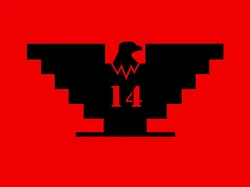
Norteños are the various, affiliated gangs that pay tribute to Nuestra Familia while in California state and federal correctional facilities. Norteños may refer to Northern California as Norte Califas. Their biggest rivals are the Sureños from Southern California. As of 2008, the statewide north–south dividing line between Norteños and Sureños was regarded as running through the southern end of the Central Valley. The gang's membership consists primarily of Mexican Americans.

The Mexican Mafia, also known as La eMe, is a Mexican American criminal organization in the United States. Despite its name, the Mexican Mafia did not originate in Mexico, and is entirely a U.S. criminal prison organization. Law enforcement officials report that the Mexican Mafia is the deadliest and most powerful gang within the California prison system.
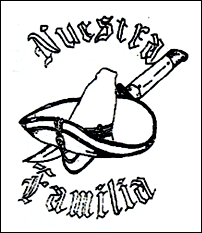
Nuestra Familia is a criminal organization of Mexican American (Chicano) prison gangs with origins in Northern California. While members of the Norteños gang are considered to be foot soldiers of Nuestra Familia, being a member of Nuestra Familia itself does not signify association as a Norteño. Some law enforcement agents speculate that the Nuestra Familia gang, which operates in and out of prisons, influences much of the criminal activity of thousands of Norteño gang members in California. The gang's main sources of income are distributing cocaine, heroin, marijuana, and methamphetamine within prison systems as well as in the community and extorting drug distributors on the streets.
A prison gang is an inmate organization that operates within a prison system. It has a corporate entity and exists into perpetuity. Its membership is restrictive, mutually exclusive, and often requires a lifetime commitment. Prison officials and others in law enforcement use the euphemism "security threat group". The purpose of this name is to remove any recognition or publicity that the term "gang" would connote when referring to people who have an interest in undermining the system.
Peckerwood is a term for a woodpecker which is used in the Southern United States and it is also used as a racial epithet for white people, especially poor rural whites. Originally an ethnic slur, the term has been embraced by a subculture related to prison gangs and outlaw motorcycle clubs. The term was in use as an inversion of woodpecker by the 1830s, with the sense referring to white people documented from the 1850s. African-American folklore in the 1920s contrasted the white "peckerwood" bird with the African-American blackbird. The word became a common term in Jive.
Joseph Morgan was an American gangster who became the first non-Hispanic member of the Mexican Mafia. He received the nickname "Pegleg" by authorities because of his prosthetic leg.
Public Enemy No. 1, also known as PENI Death Squad, is a prison and street gang formed in Long Beach, California and now based in Orange County, California. In 2004, the California Department of Justice described PEN1 as "one of the most powerful and fastest-growing gangs inside and outside prison", and reported it had about 200 members statewide. The gang's main activities include identity theft, credit card fraud, and methamphetamine sales.

Approximately 1.4 million people in the United States were part of gangs as of 2011, and more than 33,000 gangs were active in the country. These include national street gangs, local street gangs, prison gangs, outlaw motorcycle clubs, and ethnic and organized crime gangs.
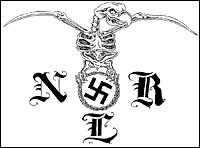
The Nazi Lowriders, also known as NLR or the Ride, are a neo-Nazi, white supremacist organized crime syndicate, and prison and street gang in the United States. Primarily based in Southern California, the gang is allied with the larger Aryan Brotherhood and Mexican Mafia gangs, and fellow peckerwood gang Public Enemy No. 1. The Nazi Lowriders operate both in and outside of prison.
The Texas Syndicate is a mostly Texas-based street and prison gang consisting of predominantly Mexican American membership. The Texas Syndicate, unlike the Mexican Mafia or Nuestra Familia, has been more associated or allied with Mexican immigrant prisoners.
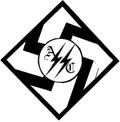
The Aryan Circle is a white supremacist, Neo-Nazi prison gang spread throughout many U.S. correctional facilities.

Sureños , also known as Southern United Raza, Sur 13 or Sureños X3, are groups of loosely affiliated gangs that pay tribute to the Mexican Mafia while in U.S. state and federal correctional facilities. Many Sureño gangs have rivalries with one another, and the only time this rivalry is set aside is when they enter the prison system. Thus, fighting is common among different Sureño gangs even though they share the same common identity. Sureños have emerged as a national gang in the United States.
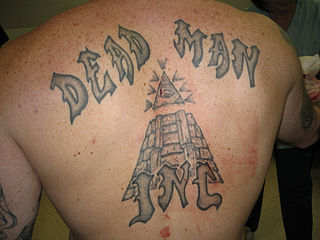
Prison tattooing is the practice of creating and displaying tattoos in a prison environment. Present-day American and Russian prisoners may convey gang membership, code, or hidden meanings for origin or criminal deeds. Lack of proper equipment and sterile environments lead to health risks such as infection or disease from contaminated needles.

211 Crew is a white supremacist prison gang, active both in and out of prison, that was formed in 1995 at Colorado's Denver County Jail. It was linked to several high-profile murders and criminal investigations. Those included the assassination of Colorado Department of Corrections head Tom Clements. Due to a threatening letter sent by a Texas Aryan Brotherhood member, it was suspected to be linked to similar assassinations of Texas district attorney Mike McLelland, and his assistant prosecutor Mark Hasse, but a former Justice of the Peace was eventually indicted for those murders.

The Aryan Brotherhood of Texas (ABT) is an American white supremacist and Neo-Nazi prison and street gang. According to the Anti-Defamation League and the Southern Poverty Law Center, the Aryan Brotherhood of Texas is one of the largest and most violent neo-Nazi white supremacist prison gangs and organized criminal enterprises in the United States, responsible for numerous murders and other violent crimes.

Project Wildfire was a nationwide, multi-agency investigation of various transnational criminal gangs in 2015 that resulted in the arrests of 976 individuals, representing 239 different organizations, in 282 cities in the United States mainland and Puerto Rico. Eighty-two firearms, 5.2 kilograms of methamphetamine, 7.8 kilograms of marijuana, 5.6 kilograms of cocaine, 1.5 kilograms of heroin, US$379,399, counterfeit merchandise with a suggested retail price of US$547,534 and five vehicles were also seized.

The Soldiers of Aryan Culture (SAC), sometimes referred to as Soldiers of the Aryan Culture and Soldiers of an Aryan Culture, is a large American white supremacist prison gang.
The Universal Aryan Brotherhood (UAB), also known as the Universal Family, are an active neo-Nazi white supremacist prison gang in the United States. Primarily based out of Oklahoma, the gang also has members in federal custody, as well as in several states across the country.
References
- ↑ "We spoke to hundreds of prison gang members – here's what they said about life behind bars | Colorado Arts and Sciences Magazine | University of Colorado Boulder". April 3, 2020.
- ↑ "White Supremacist Prison Gangs in the United States: A Preliminary Inventory" (PDF). adl.org. Retrieved March 27, 2022.
- ↑ Skarbek, David (2014). The Social Order of the Underworld: How Prison Gangs Govern the American Penal System. Oxford University Press (published July 24, 2014). ISBN 978-0199328505. LCCN 2013041577.
- ↑ "David Skarbek on Prison Gangs and the Social Order of the Underworld | EconTalk | Library of Economics and Liberty" . Retrieved April 12, 2017.
- ↑ Skarbek, David (November 2011). "Governance and Prison Gangs" (PDF). American Political Science Review . 105 (4): 702–216. doi:10.1017/S0003055411000335. JSTOR 23275348. S2CID 48293373. Archived from the original (PDF) on February 27, 2019.
- ↑ "Street Gangs — Chicago Based or Influenced, People Nation and Folk Nation". Florida Department of Corrections. Archived from the original on November 28, 1999. Retrieved March 27, 2022.
- 1 2 Skarbek, David (2011). "Governance and prison gangs". American Political Science Review. 105 (4): 702–716. doi:10.1017/S0003055411000335. S2CID 48293373.
- ↑ "Gladiator School: Stories from Inside YTS". December 13, 2020.
- ↑ "Texas Syndicate - Law Essays". April 5, 2020.
- 1 2 "Appendix B. National-Level Street, Prison, and Outlaw Motorcycle Gang Profiles - Attorney General's Report to Congress on the Growth of Violent Street Gangs in Suburban Areas (UNCLASSIFIED)".
- ↑ "www.justice.gov".
- ↑ Prison Gangs justice.gov (May 11, 2015)
- ↑ Lyman, Michael D. (2010). Drugs in Society: Causes, Concepts and Control. Elsevier. p. 496. ISBN 9781437744514.
- ↑ "Texas Gangs: An Overview of Security Threat Groups and Other Major Gangs in Texas" (PDF). Texas Department of Public Safety . Retrieved November 12, 2013.
- ↑ "www.prisonoffenders.com". www.prisonoffenders.com.
- ↑ "FBI arrests man in Texas suspected of being gang hit man". Reuters. November 26, 2014. Retrieved August 2, 2015.
- 1 2 "Major Prison Gangs". Florida Department of Corrections. Archived from the original on November 27, 1999. Retrieved March 27, 2022.
- ↑ "www.policemag.com". August 6, 2007.
- ↑ "California Halts Prison Gang Peacemaking Effort – CBS Sacramento". September 24, 2019.
- ↑ "Gang Profile: The Latin Kings | Office of Justice Programs".
- ↑ "Almighty Latin King and Queen Nation of New York and Environs | Office of Justice Programs".
- ↑ Gundur, R. V. (2020). "Negotiating Violence and Protection in Prison and on the Outside: The Organizational Evolution of the Transnational Prison Gang Barrio Azteca - R. V. Gundur, 2020". International Criminal Justice Review. 30: 30–60. doi:10.1177/1057567719836466. S2CID 150955479.
- ↑ "What you need to know about Tango Blast, Houston's most dangerous gang". August 3, 2017.
- ↑ "DPS gang assessment includes Tango Blast, MS-13 as top threats". July 26, 2017.
- ↑ "Major Prison Gangs: Black Guerrilla Family (BGF)". Florida Department of Corrections. Archived from the original on December 21, 2001. Retrieved March 27, 2022.
- ↑ Hagedorn 2008 , p. 12
- ↑ Hagedorn 2008 , pp. 80–81
- ↑ Mock, Brentin (December 1, 2007). "Aryan Circle Blamed for Two Cop Killings". Intelligence Report. Southern Poverty Law Center. Retrieved April 1, 2018.
- ↑ "The Aryan Circle: Crime in the Name of Hate" (PDF). Anti-Defamation League. December 2009. pp. 9–10. Retrieved April 1, 2018.
- ↑ "The Aryan Brotherhood of Texas". Anti-Defamation League. April 4, 2013. Archived from the original on April 23, 2015.
- ↑ "White supremacist linked to Texas car chase, Colo. slaying". CBS News. March 21, 2013. Archived from the original on March 25, 2013. Retrieved March 27, 2022.
- ↑ Wright, Paul (December 15, 1999). "Lockdown America: Police and Prisons in the Age of Crisis, by Christian Parenti (Review)" . Prison Legal News . Vol. 10, no. 12. p. 6. Archived from the original on August 5, 2020.